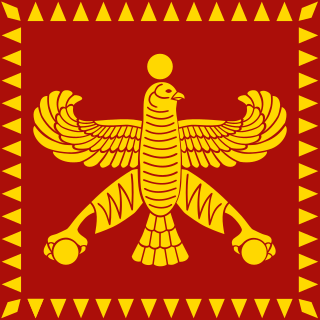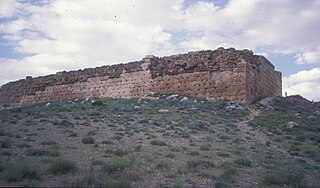The 6th century BC started on the first day of 600 BC and ended on the last day of 501 BC.

Babylonia was an ancient Akkadian-speaking state and cultural area based in the city of Babylon in central-southern Mesopotamia. It emerged as an Akkadian populated but Amorite-ruled state c. 1894 BC. During the reign of Hammurabi and afterwards, Babylonia was retrospectively called "the country of Akkad", a deliberate archaism in reference to the previous glory of the Akkadian Empire. It was often involved in rivalry with the older ethno-linguistically related state of Assyria in the north of Mesopotamia and Elam to the east in Ancient Iran. Babylonia briefly became the major power in the region after Hammurabi created a short-lived empire, succeeding the earlier Akkadian Empire, Third Dynasty of Ur, and Old Assyrian Empire. The Babylonian Empire rapidly fell apart after the death of Hammurabi and reverted to a small kingdom centered around the city of Babylon.

Belshazzar was the son and crown prince of Nabonidus, the last king of the Neo-Babylonian Empire. Through his mother, he might have been a grandson of Nebuchadnezzar II, though this is not certain and the claims to kinship with Nebuchadnezzar may have originated from royal propaganda.

Nabonidus was the last king of the Neo-Babylonian Empire, ruling from 556 BC to the fall of Babylon to the Achaemenian Empire under Cyrus the Great in 539 BC. Nabonidus was the last native ruler of ancient Mesopotamia, the end of his reign marking the end of thousands of years of Sumero-Akkadian states, kingdoms and empires. He was also the last independent king of Babylon. Regarded as one of the most vibrant and individualistic rulers of his time, Nabonidus is characterised by some scholars as an unorthodox religious reformer and as the first archaeologist.

Cyrus II of Persia, commonly known as Cyrus the Great, was the founder of the Achaemenid Persian Empire. Hailing from Persis, he brought the Achaemenid dynasty to power by defeating the Median Empire and embracing all of the previous civilized states of the ancient Near East, expanding vastly and eventually conquering most of West Asia and much of Central Asia to create what would soon become the largest polity in human history at the time. Widely considered the world's first superpower, the Achaemenid Empire's largest territorial extent was achieved under Darius the Great, whose rule stretched from the Balkans and the rest of Southeast Europe in the west to the Indus Valley in the east.
Labashi-Marduk was the fifth and penultimate king of the Neo-Babylonian Empire, ruling in 556 BC. He was the son and successor of Neriglissar. Though classical authors such as Berossus wrote that Labashi-Marduk was just a child when he became king, Babylonian documents indicate that he had been in charge of his own affairs before his rise to the throne, suggesting he was an adult, though possibly still relatively young.

The Babylonian Chronicles are a loosely-defined series of about 45 tablets recording major events in Babylonian history.

The Cyrus Cylinder is an ancient clay cylinder, now broken into several pieces, on which is written an Achaemenid royal inscription in Akkadian cuneiform script in the name of Persian king Cyrus the Great. It dates from the 6th century BC and was discovered in the ruins of the ancient Mesopotamian city of Babylon in 1879. It is currently in the possession of the British Museum. It was created and used as a foundation deposit following the Persian conquest of Babylon in 539 BC, when the Neo-Babylonian Empire was invaded by Cyrus and incorporated into his Persian Empire.

The Neo-Babylonian Empire or Second Babylonian Empire, historically known as the Chaldean Empire, was the last polity ruled by monarchs native to Mesopotamia. Beginning with the coronation of Nabopolassar as the King of Babylon in 626 BC and being firmly established through the fall of the Assyrian Empire in 612 BC, the Neo-Babylonian Empire was conquered by the Achaemenid Persian Empire in 539 BC, marking the collapse of the Chaldean dynasty less than a century after its founding.

Nebuchadnezzar IV, alternatively spelled Nebuchadrezzar IV and also known by his original name Arakha, was a nobleman of Urartian (Armenian) descent who in 521 BC seized power in Babylon, becoming the city's king and leading a revolt against the Persian Achaemenid Empire. His revolt began less than a year after the unsuccessful revolt of Nebuchadnezzar III and like his predecessor, Arakha assumed the name Nebuchadnezzar and claimed to be a son of Nabonidus, Babylon's last independent king.
Cyaxares II was a king of the Medes whose reign is described by the Greek historian Xenophon. Some theories have equated this figure with the "Darius the Mede" named in the Book of Daniel. He is not mentioned in the histories of Herodotus or Ctesias, and many scholars doubt that he actually existed. The question of his existence impacts on whether the kingdom of the Medes merged peacefully with that of the Persians in about 537 BC, as narrated by Xenophon, or was subjugated in the rebellion of the Persians against Cyrus' grandfather in 559 BC, a date derived from Herodotus (1.214) and almost universally accepted by current scholarship.
The Battle of Opis was the last major military engagement between the Achaemenid Persian Empire and the Neo-Babylonian Empire, which took place in September 539 BC, during the Persian invasion of Mesopotamia. At the time, Babylonia was the last major power in Western Asia that was not yet under Persian control. The battle was fought in or near the strategic riverside city of Opis, located north of the capital city of Babylon in modern-day Iraq, and resulted in a decisive victory for Persia. Shortly afterwards, the Babylonian city of Sippar surrendered to Persian forces, who then supposedly entered Babylon without facing any further resistance. The Persian king Cyrus the Great was subsequently proclaimed as the king of Babylonia and its subject territories, thus ending its independence and incorporating the entirety of the fallen Neo-Babylonian Empire into the greater Achaemenid Empire.

The Medo-Persian conflict was a military campaign led by the Median king Astyages against Persis in the mid 6th-century BCE. Classical sources claim that Persis had been a vassal of the Median kingdom that revolted against Median rule, but this is not confirmed by contemporary evidence though. After some battles the Persians led by Cyrus the Great emerged victorious, subsequently conquering Median territories and establishing the Achaemenid Empire.

The fall of Babylon was the decisive event that marked the total defeat of the Neo-Babylonian Empire to the Achaemenid Persian Empire in 539 BCE.

Amélie Kuhrt FBA was a British historian and specialist in the history of the ancient Near East.

Cassandane or Cassandana was a Persian Achaemenian shahbanu and the dearly loved wife of Cyrus the Great.

Nebuchadnezzar III, alternatively spelled Nebuchadrezzar III and also known by his original name Nidintu-Bêl, was a rebel king of Babylon in late 522 BC who attempted to restore Babylonia as an independent kingdom and end the rule of the Persian Achaemenid Empire in Mesopotamia. A Babylonian noble of the Zazakku family and the son of a man by the name of Mukīn-zēri or Kîn-Zêr, Nidintu-Bêl took the regnal name Nebuchadnezzar upon his accession to the Babylonian throne and claimed to be a son of Nabonidus, Babylon's last independent king.

Nidin-Bel might have been a rebel king of Babylon who in the autumn of 336 BC and/or the winter of 336–335 BC attempted to restore Babylonia as an independent kingdom and end the rule of the Persian Achaemenid Empire in the region. The only known surviving reference which points to there being a ruler by this name in Babylon is the Uruk King List, which records rulers of Babylon from the 7th to 3rd centuries BC. In this list, the rule of Darius III, the last Achaemenid king, is immediately preceded by a fragmentary reference to Nidin-Bel.

The Babylonian revolts of 484 BC were revolts of two rebel kings of Babylon, Bel-shimanni and Shamash-eriba, against Xerxes I, king of the Persian Achaemenid Empire.
















